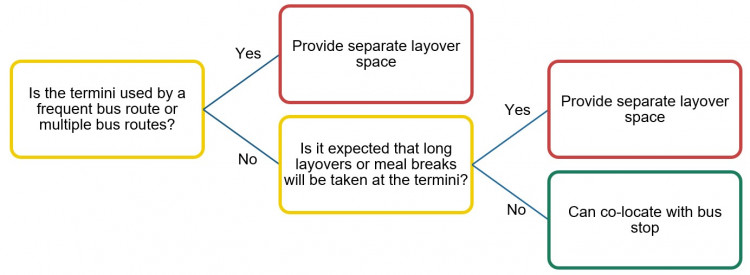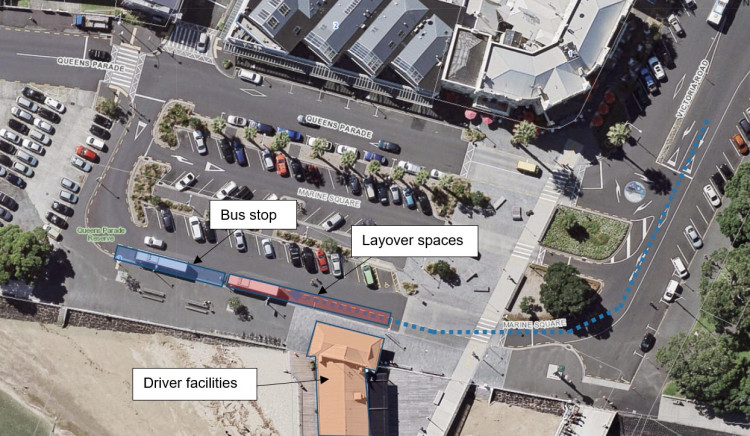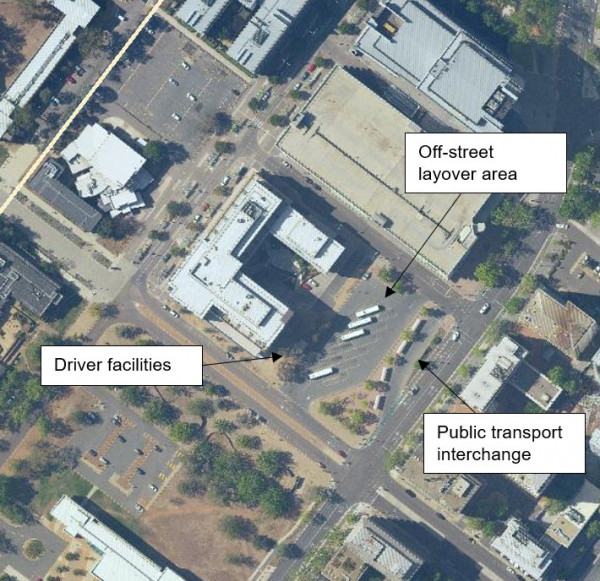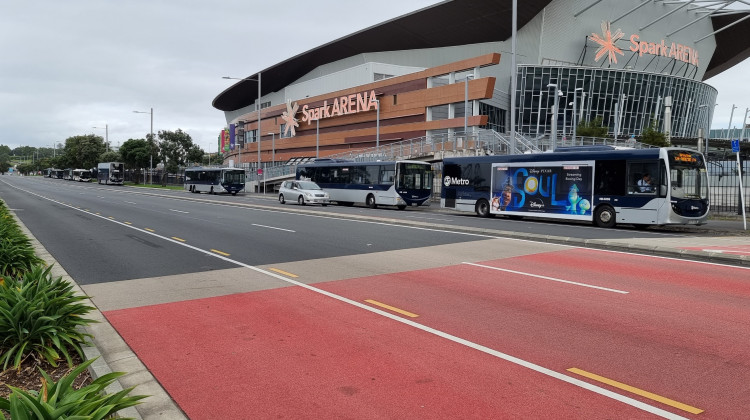There are a number of factors to consider in locating layovers.
Meeting current operational requirements for layover is essential, but it is also recommended to consider potential changes to the bus network, such as expansion or reconfiguration to ensure infrastructure is future-proofed.
Given that driver shifts are decided by bus operators, the way in which drivers’ shifts are optimised may affect the number and location of layover spaces required. Therefore, it is recommended that bus operators and public transport contracting authorities consider layover availability when rescheduling drivers shifts.
Finally, care needs to be taken to minimise any negative impacts on local amenity while balancing the need to provide layover in a location suitable to meeting operational requirements.
Co-located or separated layovers
A bus layover space can either be co-located with the terminus bus stop or a separate layover space can be provided. The choice of where to locate the layover space depends on the characteristics of the bus services which will use the layover space.
It is best practice to separate the location of a layover space and a bus stop where possible and practical. A separate layover space allows the driver the opportunity to step away from their vehicle to take their break which may not be possible at co-located bus stops where passengers expect to be able to board and wait on the bus.
A general guide to selecting the type of layover space

Guide to selecting the location of on-street layovers.
Follow these general considerations for co-located bus and layover stops:
- Layover or timing point stops must not be located at bus stops located on cycle lanes or cross vehicle entrances and exits (Road User Rule 2004)
- The Road User Rule 2004 requires that timing locations and on-street layovers be designated and signed with bus parking, which can be time limited. This will also help reduce the risk of the space being used by other vehicles (such as coaches).
- Sufficient length overall:
- the stop should be of sufficient length to enable buses to pull in and out independently without other buses needing to be moved.
- If the stop is more than one bus in-length then the in-service buses should use the head of the stop and buses laying over should use the rear of the stop.
Follow these general considerations for separate layover spaces:
- The layover space: this should be a short distance from the commencement stop.
- Line of sight: ideally the bus driver should be able to see the commencement stop from the layover space to ensure it is clear before departing.
- Clearly defined spaces: the layover space should be in a less prominent location than the bus stop so that customers do not attempt to board from the layover space.
Further information
For further information refer to the Land Transport (Road User Rule 2004), Sections 6.6, 6.9 and Definitions of ‘loading zone’ and ‘parking’:
Land Transport (Road User Rule 2004)(external link)
On-street layovers
On-street bus layovers are characterised by designated on-street parking spaces for out of service buses.
Key considerations for on-street layovers are:
-
Duration: on-street layovers are typically used when the layover duration is short.
-
Capacity: usually suited to a limited number of terminating buses or where there is ample kerb space available.
-
Amenity: avoid streets with busy, active street frontages. There may be some benefits to street amenity by splitting up layover spaces rather than concentrating them to a hub. This might result in it being harder to provide driver facilities and could also result in a more out of service running.
-
Facilities: on-street layovers can be used for meal breaks where appropriate driver facilities are provided and where stationary buses would not obstruct in-service buses.

Example of on-street bus layover from Devonport, Auckland (Source: LINZ, NZTA, Eagle Technology).
Off-street layover
Off-street layover spaces are characterised by a separate off-road parking area dedicated to out of-service buses.
Key considerations for off-street layovers are:
-
Duration: generally used in situations when there are long layovers.
-
Capacity: often such facilities are designed to accommodate a high number of terminating buses which is useful where kerb space is limited, such as in city or town centres.
-
Facilities: it is often easier to provide more extensive driver facilities compared to on-street layovers because there may be more space and less conflict with street frontages.
-
Amenity/development integration: good urban amenity outcomes are typically best achieved when an off-street layover is integrated into a wider development, with other land uses or a public transport interchange.
-
Cost: providing off-street bus layovers generally have higher costs than on-street bus layovers. This is because additional land may need to be purchased or leased for off-street bus layovers whereas road control authorities typically already control the road space used by on-street bus layovers. Off-street bus layovers may provide operating cost savings due to less out of service running and potentially lower peak vehicle or driver requirements. Public transport contracting authorities and/or road controlling authorities should undertake a holistic cost analysis which includes both the potential costs and likely benefits when considering which type of bus layover to choose.

Example of off-street bus layover area (Source: ACT Government).
Potential quantifiable benefits and costs of off-street layovers
|
Potential quantifiable benefits
|
Potential quantifiable costs
|
- Reduced out of service running
- Lower peak vehicle or driver requirements
- Improved service reliability if buses are being delayed whilst out of service
- Reduced number of driver facilities required
- Revenue from increase in paid on-street parking spaces
- Provides greater opportunity for e-charging
|
- Land purchase or rent
- Design and construction
- Operating costs eg utilities and insurance
- Asset maintenance and renewals
|
Temporary layover
A temporary layover is typically required when planning for a major event, such as construction projects or temporary service disruptions such as railway closures requiring bus replacement services. The temporary layover should be located as close as possible to the terminus stop and have enough capacity to accommodate the expected volume of terminating buses.
In establishing temporary layovers, engagement with key stakeholders such as bus operators and residents should be undertaken to ensure that operational needs are met whilst minimising any potential impacts.
Location integration
In order to minimise the potential impacts on amenity from bus layovers and integrate into the surrounding environments, the following should be considered:
- avoid positioning bus layovers close to sensitive land uses, such as houses or businesses which front directly onto the street
- where it is difficult to avoid sensitive land uses, identify locations where such buildings are set back from the street or have frontages without windows or entrances.
- the noise from an idling bus engine can cause tensions with nearby property occupiers and therefore drivers should be reminded to turn off their engines whilst at the layover. This could be achieved through signage at the layover or a note in the drivers shift cards. Buses with older diesel engines may need to idle for up to two minutes to allow the engine to cool down after which time the engine should be turned off.
- layover spaces must not be located directly across driveways or in a way that might inhibit the safe and efficient access of drivers entering or exiting a driveway.
- avoid locating bus layover in a way that is incompatible with known future land use changes including proposed or consented developments.

Example of bus layover which is located away from street frontages and does not obstruct driveways from Quay Street, Auckland (Source: Thomas Chu).



